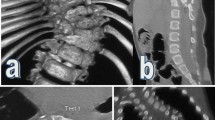Abstract
Aim
Split cord malformations (SCMs) are rare congenital anomalies of the vertebrae and the spinal cord. Tethered cord syndrome (TCS) is a clinical condition of various origins that arises from tension on the spinal cord. Radiographic findings may include and/or associate split cord malformations and the other neural tube defects. However, the spinal cord can even be tethered by a filum terminale with normal appearance and normal level conus medullaris in magnetic resonance imaging (MRI). The aim of our study is to show whether SMC patients with normal or abnormal MRI findings had all histological abnormal filum terminale and also to show that the standard SCM repairing operation without cutting filum will not achieve total release.
Material and methods
We have reviewed 33 SCM patients between July 2005 and December 2013. They were operated by adding untethering procedure of filum terminale following standard surgical intervention, and a part of the filum was taken for histopathological examination even though MRI did not show the presence of abnormality of filum terminale.
Results
We found that abnormal filum terminale with a normal appearance may had dense collagen fibers, wide and numerous capillaries, and hyaline formation, while normal filum terminale is a mixture of collagen fibers and blood vessels. We did not obtain positive Verhoeff elastic fiber staining. The elastic fibers had disappeared in all fila terminalia, except control cadaver group.
Conclusion
Our results showed that all fila of SCM patients had loss of elastic fibers and increased of hyalinization, which means loss of elasticity of filum terminale. Less severe traction may remain asymptomatic in childhood and present with neurological dysfunction later in life. For this reason, surgical procedure of SCM patients including releasing of filum terminale seems more beneficial for the patients and be better for long term.







Similar content being viewed by others
References
Bentley JF, Smith JR (1960) Developmental posterior enteric remnants and spinal malformations: the split notochord syndrome. Arch Dis Child 35:76–86
Ersahin Y (2013) Split cord malformation types I and II: a personal series of 131 patients. Childs Nerv Syst 29(9):1515–1526
Ersahin Y, Mutluer S, Kocaman S, Demirtas E (1998) Split spinal cord malformation in children. J Neurosurg 88:57–65
Hertzler DA 2nd, DePowell JJ, Stevenson CB, Mangano FT (2010) Tethered cord syndrome: a review of the literature from embryology to adult presentation. Neurosurg Focus 29(1):E1. doi:10.3171/2010.3.FOCUS1079, Review
Hoffman HJ, Hendrick EB, Humphreys RP (1976) The tethered spinal cord: its protean manifestations, diagnosis and surgical correction. Childs Brain 2(3):145–155
Hui H, Zhang ZX, Yang TM, He BR, Hao DJ (2013) Vertebral column resection for complex congenital kyphoscoliosis and type I split spinal cord malformation. Eur Spine J 14 doi:10.1007/s00586-013-3044-6
Izci V, Gonul M, Gonul E (2007) The diagnostic value of skin lesions in split cord malformation. J Clin Neurosci 14:860–863
Izci Y, Kural C (2011) Composite type of split cord malformation: rare and difficult to explain. Pediatr Neurosurg 47:461
Kim YD, Sung JH, Hong JT, Lee SW (2013) Split cord malformation combined with tethered cord syndrome in an adult. Korean Neurosurg Soc 54:363–365
Lew SM, Kothbauer KF (2007) Tethered cord syndrome: an updated review. Pediatr Neurosurg 43:236–248
Mahapatra AK (2011) Split cord malformation—a study of 300 cases at AIIMS 1990–2006. J Pediatr Neurosci 6(Suppl 1):41–45
Nievelstein RA, Hartwig NG, Vermeij-Keers C, Valk J (1993) Embryonic development of the mammalian caudal neural tube. Teratology 48:21–31
Pang D (1992) Split cord malformation. Part II: clinical syndrome. Neurosurgery 31:481–500
Pang D, Dias MS, Ahab Barmada M (1992) Split cord malformation: part I: a unified theory of embryogenesis for double spinal cord malformation. Neurosurgery 31:451–480
Pang D, Wilberger JE Jr (1982) Tethered cord syndrome in adults. J Neurosurg 57(1):32–47
Phuong LK, Schoeberl KA, Raffel C (2002) Natural history of tethered cord in patients with meningomyelocele. Neurosurgery 50:989–995
Rizk E, Adeeb N, Hussein AE, Tubbs RS, Rozzelle CJ, Oakes WJ (2014) Duplicated filum terminale in the absence of split cord malformation: a potential cause of failed detethering procedures. Childs Nerv Syst 30(4):709–711
Salunke P, Kovai P, Malik V, Sharma M (2011) Mixed split cord malformation: are we missing something? Clin Neurol Neurosurg 113(9):774–778
Selcuki M, Coskun K (1998) Management of tight filum terminale syndrome with special emphasis on normal level conus medullaris (NLCM). Surg Neurol 50:318–322
Selcuki M, Umur AS, Duransoy YK, Ozdemir S, Selcuki D (2012) Inappropriate surgical interventions for midline fusion defects cause secondary tethered cord symptoms: implications for natural history report of four cases. Childs Nerv Syst 28(10):1755–1760
Selcuki M, Vatansever S, Inan S, Erdemli E, Bagdatoglu C, Polat A (2003) Is a filum terminale with a normal appearance really normal? Child’s Nerv Syst 19:3–10
Umur AS, Selcuki M, Selcuki D, Bedük A, Doganay L (2007) Adult tethered cord syndrome mimicking lumbar disc disease. Child’s Nerv Syst 24:841–844
Yamada S, Colohan AR, Won DJ (2009) Tethered cord syndrome. J Neurosurg Spine 10:79–80, author reply 80–81
Yamada S, Won DJ, Yamada SM (2004) Pathophysiology of tethered cord syndrome: correlation with symptomatology. Neurosurg Focus 16(2):E6
Yamada S, Zinke DE, Sanders D (1981) Pathophysiology of “tethered cord syndrome”. J Neurosurg 54:494–503
Author information
Authors and Affiliations
Corresponding author
Rights and permissions
About this article
Cite this article
Barutcuoglu, M., Selcuki, M., Selcuki, D. et al. Cutting filum terminale is very important in split cord malformation cases to achieve total release. Childs Nerv Syst 31, 425–432 (2015). https://doi.org/10.1007/s00381-014-2586-1
Received:
Accepted:
Published:
Issue Date:
DOI: https://doi.org/10.1007/s00381-014-2586-1




